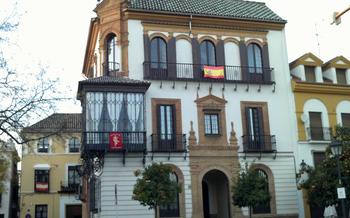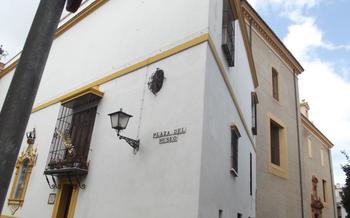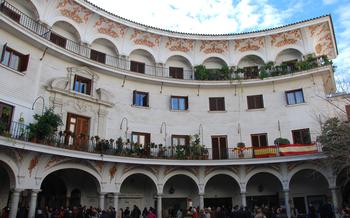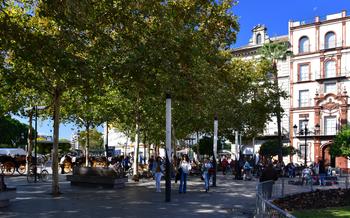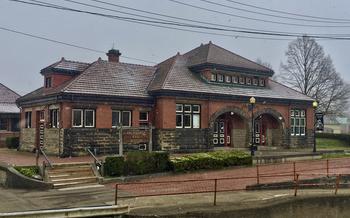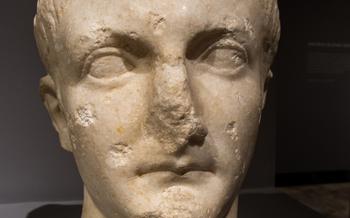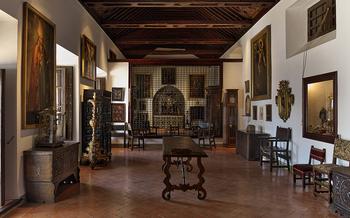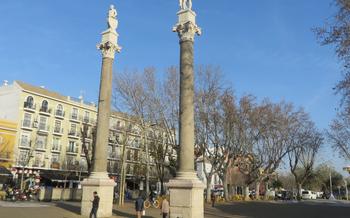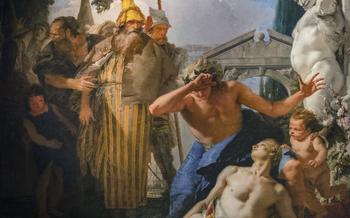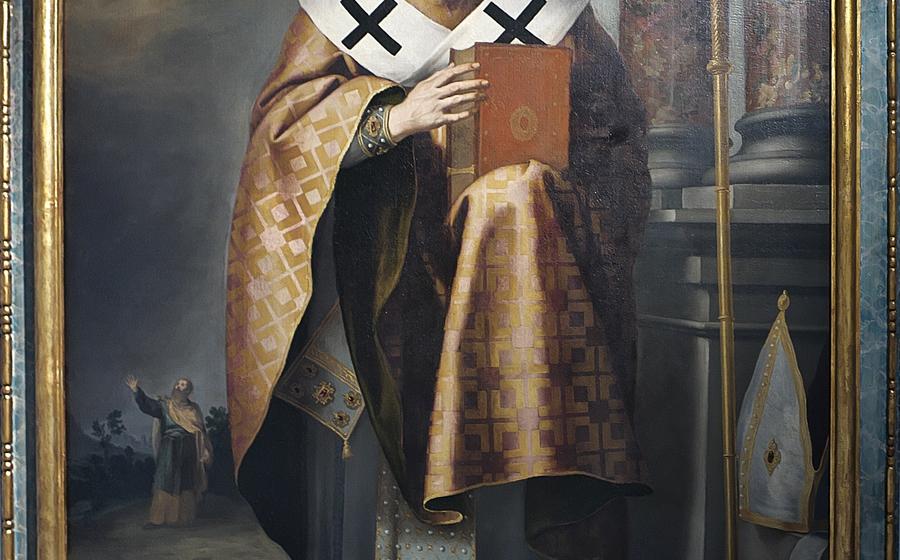
Museum of Fine Arts of Seville
- The Enriching Journey of Art: Museum of Fine Arts of Seville
- Masterpieces of the Museum
- Religious Art
- Portraits and Landscapes
- Temporary Exhibitions
- Practical Information
- Museum Shop
- Accessibility
- Family-Friendly Activities
- Photography and Social Media
- Local Restaurants and Cafés
- Nearby Attractions
- Combining Art and History
- Insider Tip
The Enriching Journey of Art: Museum of Fine Arts of Seville
Seville's Museum of Fine Arts proudly stands as a testament to the city's rich cultural legacy. Founded in 1835 during the reign of Queen Isabella II, this prestigious institution initially resided in the old convents of La Merced Calzada and San Francisco before finding its permanent home in the former Hospital de las Cinco Llagas, a magnificent 17th-century building that beautifully blends Renaissance and Baroque architectural styles. The museum boasts an impressive collection of over 6,000 artworks spanning the 13th to the 20th centuries, showcasing the evolution of art and the immense talent that has graced Seville's artistic landscape. Among the renowned artists whose works adorn the museum's walls are Bartolomé Esteban Murillo, Francisco Zurbarán, and Diego Velázquez, whose masterpieces continue to captivate and inspire visitors from around the world.
Masterpieces of the Museum
Among the museum's most celebrated masterpieces is Bartolomé Esteban Murillo's "Saint Francis Receiving the Stigmata," a poignant depiction of the saint's spiritual ecstasy. The painting's ethereal light and exquisite brushwork exemplify Murillo's mastery of the Baroque style. Another highlight is Francisco de Zurbarán's "Saint Serapion," a powerful and austere portrait of the martyred saint, rendered with Zurbarán's characteristic tenebrism. These works, along with masterpieces by other renowned artists such as Pedro de Campaña, Francisco Pacheco, and Juan de Valdés Leal, offer a comprehensive overview of the development of Spanish painting from the Renaissance to the Baroque period.
Religious Art
The Museum of Fine Arts of Seville boasts a remarkable collection of religious paintings and sculptures that offer a glimpse into the deep spiritual and artistic traditions of Spain. During the Renaissance and Baroque periods, the Church played a significant role in commissioning and patronizing art, resulting in the creation of stunning works that adorned churches, monasteries, and cathedrals.
Among the highlights of the religious collection is the masterpiece "The Descent from the Cross" by Pedro de Campaña. This poignant painting depicts the moment when Christ's body is being lowered from the cross, surrounded by grieving figures. The artist's skillful use of light and shadow creates a sense of drama and emotion, capturing the profound grief and loss experienced by those witnessing this sacred event.
Another notable work is "The Virgin of the Navigators" by Alejo Fernández. This exquisite sculpture portrays the Virgin Mary as the patroness of seafarers, holding a model of a ship in her hand. The intricate details of the Virgin's robes and the delicate features of her face reflect the artist's mastery of the sculptural form.
The museum's religious collection also includes works by other renowned artists such as Bartolomé Esteban Murillo, Francisco de Zurbarán, and Juan de Valdés Leal. These artists employed various styles and techniques to depict religious subjects, from the serene and contemplative to the dramatic and emotional.
Through these works, visitors can gain a deeper understanding of the role of religion in Spanish society and the profound impact it had on the development of art during these periods.
Portraits and Landscapes
The Museum of Fine Arts of Seville boasts a remarkable collection of portraits and landscapes that offer a glimpse into the lives and times of Seville's past inhabitants. The portraits, in particular, are a testament to the skill and artistry of the painters who captured the likeness of their subjects with remarkable precision and detail.
One of the most striking portraits in the collection is that of the "Lady with an Ermine" by El Greco. Painted in the late 16th century, the portrait depicts a young woman with a penetrating gaze and a mysterious smile. The artist's use of light and shadow creates a sense of depth and drama, highlighting the woman's elegant features and luxurious clothing.
Another notable portrait is that of "The Infanta Margarita" by Diego Velázquez. Painted in the mid-17th century, the portrait captures the young princess at the age of five, surrounded by her entourage. Velázquez's mastery of brushwork and composition is evident in the delicate rendering of the princess's features and the rich textures of her clothing.
The museum's collection of landscapes, though smaller in number, is no less impressive. One of the highlights is the "View of Toledo" by El Greco. Painted in the early 17th century, the painting depicts the city of Toledo perched on a hilltop, surrounded by a vast expanse of sky. El Greco's use of elongated forms and vibrant colors creates a sense of dynamism and energy, capturing the essence of the city's unique topography.
The evolution of landscape painting in the museum's collection is evident in the works of later artists, such as Francisco de Goya and José María Sert. Goya's "The Meadow of San Isidro" depicts a tranquil scene of a meadow with figures engaged in various activities. Sert's "The Garden of the Alcazar" portrays the lush gardens of the Alcázar of Seville, with its vibrant colors and intricate details.
These portraits and landscapes offer a fascinating glimpse into the artistic traditions of Seville and the lives of its people. They provide a valuable insight into the social, cultural, and historical context of the city, making the Museum of Fine Arts of Seville a must-visit destination for any art enthusiast or history buff.
Temporary Exhibitions
The Museum of Fine Arts of Seville boasts a dynamic program of temporary exhibitions that showcase a diverse range of art forms from different periods and cultures. These exhibitions provide visitors with an opportunity to explore new and innovative artistic expressions, and to learn about the latest trends in the art world.
Past exhibitions have included retrospectives of renowned artists such as Pablo Picasso and Salvador Dalí, as well as thematic exhibitions exploring specific artistic movements or historical periods. The museum also hosts exhibitions of contemporary art, featuring the work of emerging and established artists from around the world.
Temporary exhibitions are an important part of the museum's mission to engage and educate visitors. They offer a fresh perspective on art and history, and they help to keep the museum relevant and exciting. Visitors are encouraged to check the museum's website or social media pages for information about upcoming exhibitions.
Practical Information
The Museum of Fine Arts of Seville is located in the heart of the city, on Plaza del Museo, It is open Tuesday through Sunday from 9:00 a.m. to 3:00 p.m. Admission fees are €50 for adults, €00 for students and seniors, and free for children under
The museum offers guided tours in Spanish, English, French, and German for an additional fee. Audio guides are also available in a variety of languages for €00.
The museum shop is located on the ground floor of the building and offers a wide range of souvenirs, books, and reproductions of artwork. Visitors can also purchase unique items such as jewelry, ceramics, and textiles inspired by the museum's collection.
The museum is fully accessible to visitors with disabilities. Ramps, elevators, and wheelchair-accessible restrooms are available throughout the building. The museum also offers guided tours and educational programs for visitors with disabilities.
Museum Shop
The Museum of Fine Arts of Seville boasts a well-stocked museum shop that offers a wide range of souvenirs, books, and reproductions of artwork. Visitors can find unique items such as replicas of ancient sculptures, prints of famous paintings, and handmade ceramics inspired by the museum's collection. The shop also carries a selection of art-related books, including exhibition catalogs, artist monographs, and guides to the museum's collection. By purchasing items from the shop, visitors not only take home a memento of their visit but also support the museum's educational and conservation efforts. The shop's friendly and knowledgeable staff is always happy to assist visitors in finding the perfect item to remember their visit to the Museum of Fine Arts of Seville.
Accessibility
The Museum of Fine Arts of Seville is committed to making its collections and exhibitions accessible to all visitors, regardless of their physical abilities or disabilities. The museum features a variety of accessibility features to ensure that everyone can enjoy their visit.
Wheelchair users and visitors with limited mobility can access the museum through ramps and elevators. The museum also provides wheelchairs for visitors who need them. Wheelchair-accessible restrooms are available throughout the museum.
The museum offers guided tours and audio guides in sign language for visitors who are deaf or hard of hearing. The museum also provides transcripts of all audio tours and videos.
Visitors with visual impairments can use the museum's tactile maps and audio descriptions of the artwork. The museum also offers guided tours for visitors who are blind or visually impaired.
The Museum of Fine Arts of Seville is committed to providing a welcoming and inclusive environment for all visitors. If you have any questions or concerns about accessibility, please contact the museum's visitor services department.
Family-Friendly Activities
The Museum of Fine Arts of Seville recognizes the importance of making art accessible and enjoyable for visitors of all ages, especially children. To this end, the museum offers a range of family-friendly activities and programs designed to engage and educate young visitors.
One popular program is the "Family Sundays" initiative, which takes place on the first Sunday of every month. During these special days, the museum offers free admission for children under 12, as well as a variety of interactive activities and workshops. These activities may include art-making sessions, guided tours tailored for children, and scavenger hunts that encourage families to explore the museum's collection in a fun and engaging way.
The museum also features several interactive exhibits that are particularly suitable for young visitors. For example, the "Touch and Feel" exhibit allows children to explore replicas of famous sculptures using their sense of touch, while the "Colors of Seville" exhibit invites them to experiment with different colors and create their own works of art.
To further enhance the museum experience for families, the Museum of Fine Arts of Seville provides a range of educational materials and resources. These include activity sheets, coloring books, and audio guides that are specifically designed for children. By offering these resources, the museum aims to make art accessible and enjoyable for visitors of all ages, fostering a love of art and culture in the next generation.
Photography and Social Media
The Museum of Fine Arts of Seville encourages visitors to share their experiences on social media, using the hashtag #MuseumSeville. However, it is important to respect the museum's rules and regulations when taking photos.
- Flash photography is not allowed. This is to protect the artwork from damage.
- Tripods and selfie sticks are not permitted. These can be disruptive to other visitors and can damage the artwork.
- Please be respectful of other visitors when taking photos. Do not block their view or take photos of them without their permission.
By following these guidelines, you can help to ensure that everyone has a positive experience at the Museum of Fine Arts of Seville.
Local Restaurants and Cafés
After immersing yourself in the artistic wonders of the Museum of Fine Arts of Seville, you may want to savor some of the city's culinary delights. Fortunately, the museum is surrounded by a plethora of local restaurants and cafés that offer a diverse range of dining options.
Just a stone's throw from the museum, you'll find the charming La Antigua Taberna, a traditional Spanish restaurant that serves up mouthwatering tapas and local dishes in a cozy and welcoming atmosphere. For a taste of authentic Andalusian cuisine, head to Casa Morales, a family-run restaurant that has been serving traditional dishes for over a century.
If you're in the mood for something a little more contemporary, try Ovejas Negras, a modern tapas bar that offers a creative twist on classic Spanish dishes. For a quick and casual bite, pop into La Brunilda, a popular café that serves delicious pastries, sandwiches, and coffee.
No matter what your taste or budget, you're sure to find something to satisfy your hunger near the Museum of Fine Arts of Seville. Be sure to venture out and explore the local culinary scene to make your visit to Seville a truly memorable experience.
Nearby Attractions
The Museum of Fine Arts of Seville is ideally situated in the heart of the city, surrounded by a wealth of other attractions that are easily accessible on foot, by bus, or by taxi. Within a short walking distance, visitors can explore the grandeur of the Seville Cathedral, a UNESCO World Heritage Site and one of the largest Gothic cathedrals in the world.
Just a stone's throw away, the Alcázar of Seville, a magnificent palace that served as the residence of the Spanish monarchs for centuries, awaits discovery. Its intricate Mudejar architecture and lush gardens transport visitors back in time, offering a glimpse into the opulent lifestyle of Spain's royalty.
For those seeking a tranquil retreat, the picturesque Maria Luisa Park, located adjacent to the Plaza de España, offers a serene oasis amidst the bustling city. Its tree-lined paths, colorful flowerbeds, and ornate fountains provide a delightful escape from the urban landscape.
Art enthusiasts can further immerse themselves in the city's vibrant art scene by visiting the nearby Museum of Contemporary Art (MAC Sevilla) or the Flamenco Dance Museum, which showcase a diverse range of artistic expressions from modern masters to traditional flamenco performances.
Seville's rich history is also evident in its many churches and monuments, such as the Torre del Oro, a 13th-century watchtower that once guarded the city from invaders. The Plaza de Toros de la Maestranza, one of the oldest and most renowned bullrings in Spain, offers a glimpse into the controversial yet deeply rooted tradition of bullfighting.
With so much to see and experience in close proximity to the Museum of Fine Arts of Seville, visitors are spoilt for choice. Whether their interests lie in art, history, architecture, or culture, Seville has something to offer every traveler.
Combining Art and History
Seville is a city steeped in history and culture, offering a unique opportunity to combine art appreciation with historical exploration. The Museum of Fine Arts of Seville is just one of many cultural gems in this vibrant city. To fully appreciate the significance of the artwork housed within the museum, it is essential to understand the historical context in which it was created.
Seville has a rich and storied past, dating back to its founding by the Romans in the 2nd century BC. The city has been ruled by various civilizations over the centuries, including the Visigoths, the Moors, and the Christians. This diverse heritage is reflected in the city's architecture, cuisine, and cultural traditions.
When visiting the Museum of Fine Arts of Seville, take the time to explore the surrounding area and discover other historical landmarks. The Alcázar of Seville, a UNESCO World Heritage Site, is a magnificent palace that was built by the Moorish rulers of Seville in the 11th century. The Seville Cathedral, another UNESCO World Heritage Site, is one of the largest Gothic cathedrals in the world and is the final resting place of Christopher Columbus.
By combining art and history in Seville, you can gain a deeper understanding of the city's rich cultural heritage. The Museum of Fine Arts of Seville offers a window into the artistic achievements of the past, while the city's historical sites provide a tangible connection to the events and people that shaped Seville's unique identity.
Insider Tip
One lesser-known fact about the Museum of Fine Arts of Seville is that it houses a secret room, known as the "Sala Reservada." This room is not open to the public, but it contains a collection of artworks that are considered too controversial or explicit to be displayed in the main galleries. If you are lucky, you may be able to convince a museum staff member to show you the Sala Reservada, but be prepared to be shocked and amazed by what you see!
Here's a practical tip for your visit: The museum is often crowded during the day, especially during the summer months. To avoid the crowds and enjoy a more peaceful experience, try visiting the museum in the early morning or late afternoon. You'll have the galleries almost to yourself and be able to appreciate the artwork without distractions.
